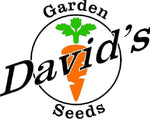Planting and Growing Peppers

On this page, I talk about planting and growing peppers, with many helpful tips and some advice based on my (David's) own experiences.
Before beginning read our pages on germination, soil testing and soil temperature.
There are three main groups of peppers: sweet bell, sweet specialty peppers and hot peppers.
While sweet peppers are limited to bell and specialty, hot peppers have a lot of choices.
There are the usual hot peppers but then there are cayenne, chili, jalapeno, Serrano and ornamental peppers. There are probably more but these are the ones we focus on.
Peppers are graded on their Scoville rating. This rating gives the heat level of each pepper. However this rating is an estimate of how hot a pepper will be. It is not an exact science since growing environments play a role in how much "heat" a certain type of pepper will have.
Bell pepper seeds will generally come up in 14 to 21 days. They will pretty much all come up within a few days of each other.
Hot pepper seeds can take 21 to 28 days to come up. However, from the day the first seed comes up, it can take one to two weeks to achieve complete germination.
Reapers and ghost peppers are two that fall into this category.
Peppers grow at various speeds. Bells grow fairly fast while hot peppers are slower with the reaper and ghost being some of the slowest. It can take months to get even a six inch plant.
Peppers can be harvested when green or let them ripen to their mature color — providing you with a longer harvest window as well as the opportunity for stunning multi-color market displays. You can eat many of them fresh, while some will need to be dried, pickled, and with the proper equipment, roasted.
I do not recommend eating Ghost and Reaper. You may burn your mouth beyond all repair.
Peppers love the heat and hate the cold. They do not like temps below 50 degrees F and will not produce when temps are above 90 degrees.
Sow seeds 8 weeks prior to planting outside. Pepper seeds should be planted ¼" deep in a fine-textured seed-starting mix or vermiculite to provide good drainage.
Even though they can be directly sown, I would suggest starting inside.
I like to recommend using 4 x 4 square black pots or 3 inch CowPots to start the seeds in.
When the seedlings are about 7 to 8 weeks old, they should be 6 to 8 inches tall.
Ideally, they will have some buds but no open flowers.
Harden off the plants before planting outside.
Peppers perform best in well-drained, fertile soils with a pH of 6.5. Abundant levels of phosphorus and calcium will result in better yields.
When the weather has settled and the threat of frost has passed, the peppers can be planted into the garden.
Bury them at the same level they are in the pot. Any deeper and you risk rotting the stem.
Peppers have perfect flowers, meaning each flower has both male and female parts and the plants can self-pollinate. Bees and other pollinators are not necessary for fertilization and fruit production but if in a greenhouse they will need a light breeze.
The books say to prevent bacterial spot and Phytophthora, drip irrigate only, plant in well-drained soils and minimize soil compaction. We use a spray irrigation system and have no problems with any diseases.
Sunscald is caused by an inadequate foliage canopy. Prevent blossom end rot with adequate soil calcium and regular moisture. Do not prune.
Big bushy plants with few peppers can be caused by an excess of nitrogen, hot or cold temperature extremes during the flowering period.
Most peppers can be picked green or left on the plant until they mature to their ripened color.
Hot pepper plants will grow to a height of 12 to 24 inches while sweet peppers can grow from 12 to 48 inches tall. I did have some hot pepper plants last year (May 2019) that grew to 48 inches tall.
Picked fresh, they will last about two weeks in the refrigerator. Most peppers can be dried thus adding months to their shelf life.
They can also be frozen.







Thanks for the tips on growing the pepper seeds. My first try on the chilitepin did not germinate but since then I have gotten grow mats and better starting soil for ya’ll when I visited your store and farm. Am looking forward to giving it another try and following your suggestions. Thank you for all that ya’ll are doing to help us all be better gardners..!!!
Leave a comment